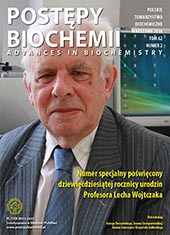Changes of mitochondrial dynamics as a response to mitochondrial stress in models of sporadic Parkinsonâs disease
Abstract
Sporadic Parkinsonâs disease (sPD) is one of the most common neurodegenerative diseases. Degeneration of dopaminergic neurons in the substantia nigra and the stratium, are the hallmarks of the disease. Numerous studies have shown that dysfunctions of mitochondrial respiratory chain complex I and oxidative stress are associated with sPD development. Mitochondria are dynamic organelles, constantly undergoing processes of fusion and fission. Shape of mitochondrial network is modified in accordance to cellular needs and external stimuli. Growing number of evidence show the presence of disturbances of mitochondrial dynamics in sPD. The aim of this article is to summarize recent data concerning role of mitochondrial dynamics in sPD pathogenesis.
Downloads
Published
Issue
Section
License
All journal contents are distributed under the Creative Commons Attribution-ShareAlike 4.0 International (CC BY-SA 4.0) license. Everybody may use the content following terms: Attribution — You must give appropriate credit, provide a link to the license, and indicate if changes were made, ShareAlike — If you remix, transform, or build upon the material, you must distribute your contributions under the same license as the original. There are no additional restrictions — You may not apply legal terms or technological measures that legally restrict others from doing anything the license permits.
Copyright for all published papers © stays with the authors.
Copyright for the journal: © Polish Biochemical Society.




